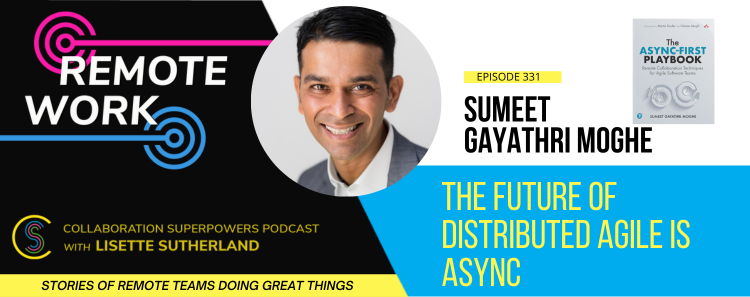
SUMEET GAYATHRI MOGHE is a product manager, a future of remote strategist, and the author of the Async-First Playbook: Remote Collaboration Techniques for Agile Software Teams. In this interview, we discuss what problems asynchronous work solves, why it’s challenging and worth it, where teams can begin, and why the future of distributed agile is async.
- Sumeet Gayathri Moghe on LinkedIn
- Async Agile website
- Async-First Playbook: Remote Collaboration Techniques for Agile Software Teams
- NOTE: The code “SUPERPOWERS” is active until 20 Sept 2023. Listeners get a 35% discount on the list price.
- Async-First Starter Kit (Chapter 29)
- Sumeet’s photography
 Asynchronous Over Synchronous Communication
Asynchronous Over Synchronous Communication
Too much synchronous communication can interrupt your focus and kill productivity. Asynchronous communication, where you don’t need immediate responses, allows you and your team to engage in deep work. To go async-first, everyone on the team has to be committed. If there are resistant people, look for the bright spots and start where possible.
- Limit Synchronous Meetings: Reserve video calls for complex decisions or team bonding.
- Encourage Written Updates: Use written forms of communication for regular updates.
- Utilize Collaboration Tools: Use software to keep everyone in the loop without constant meetings.
Intentional Work Design
Ambiguity is a productivity killer. If you need clarification on your tasks or goals, you’ll spend more time figuring out what to do than actually doing it. The inertia within teams to adopt new ways of working is a real issue. Especially when immediate productivity might take a hit. This needs to be supported by senior leaders who can see the long-term benefits over the short-term difficulties.
- Task Breakdown: Clearly outline the steps for each project.
- Prioritize: Use timeboxing techniques to focus on the most critical work.
- Set Milestones: Create checkpoints to evaluate your progress and adjust as needed.
Mental Health and Well-being
Remote work offers freedom but can also lead to feelings of isolation or burnout. It’s essential to prioritize mental health to sustain long-term productivity and happiness.
- Scheduled Breaks: Use time management methods to insert breaks into your workday.
- Set Boundaries: Clearly distinguish between work time and personal time. Physically separate your workspace if possible.
- Social Interaction: Schedule casual virtual coffee breaks or in-person meetups to maintain social connections with your team.
Collaboration and Team Dynamics
The effectiveness of a remote team hinges on its ability to collaborate seamlessly.
- Use Collaboration Tools: Adopt tools for project management and brainstorming.
- Regular Check-Ins: Have regular one-on-ones to discuss progress and address any roadblocks.
- Team Building: Host regular team-building activities (both online and in-person) to foster rapport and improve team dynamics.
The overarching sentiment is clear: the future of distributed agile is async. By adopting asynchronous communication, fostering intentional work design, prioritizing mental health, and enhancing collaboration, teams can realize the full potential of remote work.
The onus is not just on individual contributors but also on leadership to guide these practices into a cohesive strategy. With these pillars in place, remote teams are not merely surviving but thriving, heralding an era where the future of distributed agile is unquestionably asynchronous.
The fabulous Miro, a visual online workspace, has sponsored this podcast episode. Visit miro.com/superpowers to get your three free whiteboards today.
Miro is a collaborative online workspace where you can visualize every idea, project, or workflow with the help of ready-made templates and tools. It’s built for teams to feel like they’re sitting side-by-side, even working in different places.

